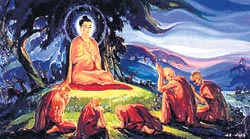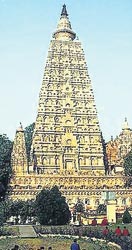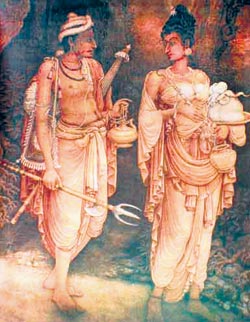The history of the Dalada Perahera
By Gamini Jayasinghe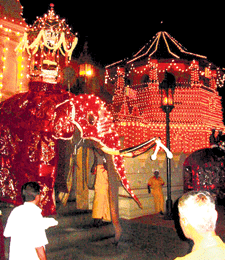
According to the chronicles King Guhasiva of Kalinga in East India had in his possession the left canine Tooth of the Buddha which he held in the highest esteem. It was believed that it was the ruler who had the Tooth Relic with him that was blessed with divine power to rule the subjects. Another king of a kingdom in the same region waged war with King Guhasiva in a bid to possess the Tooth Relic. The king was determined not to hand over the Relic to the enemy. However, he was not confident in combating the enemy and the alternative for him was to send the Tooth Relic to King Mahasena of Sri Lanka who was his friend and contemporary. Thereupon, King Guhasiva arranged his own daughter, princess Hemamala to take the Tooth Relic to Sri Lanka.
She was asked to go in disguise with her husband prince Danta. It was during the fourth century BC that princess Hemamala hid the Tooth Relic in her knot of hair and embarked from Thambulipuththu in India with prince Danta. They disembarked at Ilankeethurai in Trincomalee’s Kochchiyar Paththu. It was king Mahasena’s son King Kithsiri Mewan who was the king at that time. King Kithsiri Mewan received the Tooth Relic with reverence, paid it the highest honours, laid it in an urn of pure crystal and brought it to a building called “Dhammacakka” built by King Devanampiyatissa in the royal territory. This temple came to be known as the Temple of the Tooth Relic.
The origin of the present Dalada Perahera is the procession organized on the direction of King Meghawarna to take in procession the Tooth Relic from the Dalada Maligawa in the inner court house to Abhayagiri Viharaya. The king decreed that the Tooth Relic should be brought to Abhayagiri Viharaya annually and that sacrificial ceremonies should be conducted. Accordingly these rites had been observed to the letter up to the fifth century BC with royal patronage and without any interruption.
The Chinese pilgrim monk Fa-hsien who lived for two years in Abhayagiri Viharaya had made a note about the Dalada Perehera.
“Midway between the third and fourth months of every year the Sacred Tooth Relic is exhibited to the people. Ten days ahead of the exhibition an announcement is made on the streets by a public crier mounted on a caparisoned elephant. This is done by beating a drum used to proclaim commands”.
Until the time of shifting the country’s capital from Anuradhapura to Polonnaruwa, it is believed that the Sacred Tooth Relic had been housed in the temple near the Mahapali Alms Hall built by King Devanampiyatissa to provide meals for the monks from the royal palace. Near Mahapali alms hall there are tall columns of stones and according to an inscription it is stated that the ancient Temple of the Tooth Relic was located there.
Subsequent to the fall of the Anuradhapura kingdom the Sacred Tooth Relic was brought to Polonnaruwa. After liberating the country from the South Indian invaders, King Vijayabahu I in the 11th century constructed a two storied building called the Atadage for the Temple of the Tooth Relic and the Bowl Relic.
The upper storey housed the Tooth Relic and the Bowl Relic and the ground floor was used as an image house. This is one of the oldest buildings in Polonnaruwa. The buildings are located in an open square area which is really the terrace of the Tooth Relic palace.
According to a rock inscription found there, South Indian soldiers known as “Velaikkaras” had been employed to protect the relics enshrined there. According to some rock inscriptions of King Nissankamalla, he had built an enlarged double storied building known as the Hatadage with a masterfully carved doorway. In this building too the Tooth Relic and the Bowl Relic were housed in the upper floor and the ground floor was for the image house.
According to the Mahawamsa, the Sri Dalada Perahera had been conducted in a noble way during the reign of King Parakramabahu the Great and Panditha Parakramabahu. The streets of Polonnaruwa decorated for Sri Dalada Perahera under the direction of King Parakrama Bahu the great were compared by the author of Mahawamsa to the Sakra’s street called “Sudarshana” and the terrace of the Tooth Relic Temple to the Wesamunipura”.
“The road about one ‘Yoduna’ or sixteen miles long from the royal palace up to the Dalada Maligawa situated at the centre of the city was levelled and either side of the road was decorated with canopies, wall paintings, triumphal arches or pandals, blinds of wicker work and festoon work and the street was not second to “Sudarshana”, the street of Sakra and the terrace of the Sacred Tooth Relic Temple was more variegated than “Wesamunipura”.
King Panditha Parakramabahu brought the Sacred Tooth Relic to his native village Siriwardenapura which is supposed to be a village situated close to Dambadeniya. From Siriwardanepura the king shifted the Sacred Tooth Relic to his capital at Dambadeniya.
The author of the Mahawamsa has illustrated how the Sacred Tooth Relic was held in high esteem by King Panditha Parakramabahu.
“The Sacred Tooth Relic and the Bowl Relic were carried in a beautifully decorated chariot. Flags variegated with gold and silver were hoisted. Similar banners too were displayed. Full water pots and flower vases made of gold and silver were placed at various points. Ministers and service men followed the chariot attentively”.
There is historical evidence to the effect that the Sri Dalada Perahera had been conducted annually throughout history except during the period when Yapahuwa was the capital of Sri Lanka.
No mention is made in the chronicles about the Dalada Perahera conducted during this period. Even the ruins of most of the buildings of Yapahuwa kingdom are not existant today.
However, there remains a small building to the right side of the Dagaba which is regarded as the Temple of the Tooth Relic. There is an opening in a wall of the inner chamber. Presumably it was through this opening that the devotees had watched and worshipped the Sacred Tooth Relic.
Details of the Dalada Perahera during the Kurunegala period are available in the “Dalada Siritha” composed by King Parakramabahu IV.
“The temple of the Tooth Relic is whitewashed, canopied and decorated with silk before commencing the Sri Dalada Perahera at the auspicious moment. The king, accompanied by the ministers, women from the inner chambers of the palace and the residents of the city, offer alms, flowers, incense etc. on all seven days when the Perahera is conducted.
“The streets were illuminated. The chariot carrying the sacred Tooth Relic was drawn by a tusker which was regarded as a promoter of prosperity. The Maha Sangha followed the chariot chanting Pirith. Pirith thread was connected to the chariot carrying the Sacred Tooth Relic.”
There is historical evidence to the effect that during the Kotte period too the Sacred Tooth Relic was held in high esteem, worshipped and various types of offerings made and about a Dalada Perahera. In literal works during this period attempts had been made to exaggerate the grandeur of the Hindu temple rather than the Buddhist temple. In Nikaya Sangrahaya it is stated that Sri Dalada Pooja had been performed by four Devalayas on the four quarters. Most of the structures belonging to the Sri Dalada Maligawa during the Kotte period had been destroyed by the Portuguese.
King Wimaladharmasuriya who was enthroned in 1590 brought the Sacred Tooth Relic from Delgamuwa where it was kept hidden and performed the Esala Perahera in a bid to get his royal dignity and the prosperity of his kingdom established. This perahera had been organized on behalf of the four Devalayas.
Robert Knox had observed the Kapurala of the Devalaya as the most important person in the Perahera.“The Kapurala of the Devalaya wearing a mouth band and holding a pole wrapped partly with silk cloth and decorated with flowers leads the perahera. The devotees who throng the place worship and make offerings. The Kapurala mounted on a tusker attired in a white dress and holding the sacred pole parades the streets elegantly and magnificently. The tusker is accompanied by two other elephants on either side and followed by a retinue of elephants, dancers and torch bearers”. What Robert Knox highlighted was an account of the Devala Perahera conducted during that time.Under the guidance and admonition of Weliwita Sri Saranankara Sangharaja Thera the attitudes of the rulers were changed. They realized how the Dalada Maligawa Perahera should be conducted as a national event to pay respects to the Sacred Tooth Relic. According to historical records King Vimaladharmasooriya II had constructed the Temple of the Tooth Relic in Kandy and his son King Narendrasinghe had improved it by converting it to a two storied building. The last King of Kandy, Sri Wickrema Rajasinghe had made several alterations and added the octagon or dais known as the “Pattiruppuwa”. The traditional multi-storied buildings can be regarded as a style coming down from the Anuradhapura period. The Tooth Relic Temple or Sri Dalada Maligawa we have today in Kandy had been constructed according to the traditional art forms of the Sinhalese. The walls, the ceilings, the columns and the roof are adorned with not only traditional motifs but also its techniques. Service rituals are held daily in the morning, noon and the evening and annually a number of ceremonies such as the Vesak Mangallya, Avrudu Mangallya and Aluth Sahal Mangallya are conducted in addition to the world famous Esala Perahera which consists of the Kumbal, Randoli, Day Perahera and the water cutting ceremony on the banks of the Mahaweli Ganga at Gatambe.
The procession consists of the Dalada Perahera followed by the processions of the four Devalayas (Sathara Devalaya) Natha, Vishnu, Kataragama and Pattini.The Esala Perahera is held during the month of Esala (August) and traverses the streets of Kandy to venerate the sacred Tooth Relic. This procession embodies all the traditional forms of music and dancing and conducted at night, illuminated both by electricity and oil lamps. Hundreds of elephants including tuskers in addition to the Diyawadana Nilame, Peramunerala various other officers of the Sri Dalada Maligawa, Basnayake Nilames of the four Devalayas, dancers and drummers add colour and profundity to the procession.
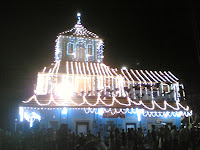.jpg)


